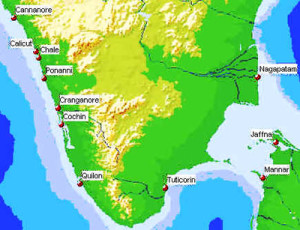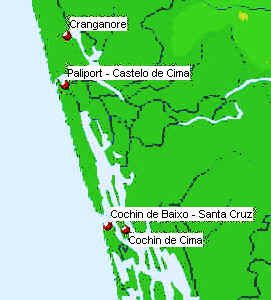Written by Marco Ramerini. English text revision by Dietrich Köster.
The city of Cochin (today: Ernakulam) was from the 24 December 1500, when the first Portuguese fleet called on its port, a firm ally of the Portuguese. The admiral of this fleet was Pedro Alvares Cabral (the discoverer of Brasil). The Rajah (king) of Cochin allowed, a “feitoria” (factory) to be allocated to the Portuguese and upon Cabral’s departure he allowed 30 Portuguese and four Franciscan friars to stay in Cochin.
In 1502 a new expedition under the command of Vasco da Gama arrived at Cochin and the friendship with the Rajah of Cochin was renewed. After the departure of Vasco da Gama the Zamorin of Calicut, enemy of the Portuguese, attacked Cochin and destroyed the Portuguese “feitoria”.
The Rajah of Cochin and his Portuguese allies were forced to withdraw to the island of Vypin. Here they were reinforced by the crews of three ships under the leadership of Francisco de Albuquerque and some days later by Duarte Pacheco Pereira (the author of “Esmeraldo de situ orbis”) and the Calicut troops immediately abandoned the siege.
On 27 September of 1503 the foundations of a timber fortress were laid. This was the first fortress erected by the Portuguese in India.
On departure of the Portuguese fleet bound for Portugal Duarte Pacheco Pereira was left behind with three ships in Cochin for the assistance to the Rajah. Meanwhile the Zamorin of Calicut formed a force of 50,000 men and 280 ships to drive the Portuguese out of Cochin. Duarte Pacheco Pereira was in command of only 100 Portuguese, 300 Malabar troops and about 5,000 soldiers of the King of Cochin (of whom the majority deserted).
Pereira was a formidable commander. For five months he and his men were able to sustain and drive back all the assaults of Zamorin. He saved Portugal from being driven out of India. After this victory Pereira returned to Portugal and the King paid him the highest honours. However, subsequently he was to be imprisoned on charges, which afterwards proved to be false. Later he became Governor of the castle of São Jorge da Mina (1519-1522) on the Gold Coast. He concluded his days in obscure poverty.
[divider]
[divider]
In 1505 a stone fortress replaced the wooden fortress of Cochin. The first church of Cochin was São Bartolomeu, built in 1504. In 1506 the construction of Santa Cruz church (which gave its name to the Portuguese town) was initiated. The foundation of the parish church Madre de Deus was laid in 1510. In 1550 the Jesuits added a large three-storied college to the church.
For a better defence of the town a fort called “Castelo de Cima” was built on Vypeen island at Paliport. In 1510 Afonso de Albuquerque started a school (a Portuguese “casado” Afonso Alvares was the teacher), but after his death it closed down. However, the Franciscans started a new school in 1520. They built a friary (Santo António) (1518-1520), a seminary and the beautiful church dedicated to São Francisco de Assis (1516-1522). Vasco da Gama was originally buried in it on Christmas eve 1524. The floor of this church was paved with tombstones, which in 1887 were removed and fixed on its walls, where they are still today. This church is a living historical monument of today’s Cochin.
At the beginning of XVI century Cochin was the seat of the Portuguese in India, including the time of the capture of Goa in 1510. The transfer of the capital of Portuguese India to Goa finally took place in 1530. In 1557 the palace of the King at Mattancheri was built. After the VOC (Dutch East India Company) conquest of Cochin in 1663) this palace was enlarged by the Dutch and is known today as the “Dutch Palace”. In 1558 the diocese of Cochin was erected and the Basílica de Santa Cruz became the cathedral. The old city of Cochin was called “Cochim de Cima” (today Mattancherry) and is situated on an island of a canal. The Portuguese town was called “Cochim de Baixo” or “Santa Cruz”.

In the 1630s its population consisted of 500 “casados” (of these 300 were Portuguese or Eurasians, the rest being Christian Indians). The town had a city council (“câmara”), a cathedral, a customs house, a “Confraria da Misericórdia” (1527), a Jewish synagogue (1568), five parish churches and several convents. The town was partly encircled by walls with several ramparts. Right after Goa the city of Cochin, situated in the center of East Indies, was the best place Portugal had in India. From there the Portuguese exported large volumes of spices, particularly pepper.
Therefore the Dutch set their eyes on Cochin and after the occupation of Ceylon in 1658 they tried to conquer Malabar. They took Quilon on 29 December 1658, but the Portuguese reconquered it on 14 April 1659. However, in 1661, the Dutch began a new expedition against the Portuguese settlements in Malabar. On 16 February they captured the fort of Pallipuram (near Cochin).

Another Dutch expedition under Ryckloff van Goens conquered Quilon on 24 December 1661 and on 15 January 1662 Cranganore was also taken. Soon after, on 5 February 1662, the Dutch began their assault on Cochin, but encountering heroic Portuguese resistance, they abandoned the siege after one month.
They came back in November 1662 and surrounded Cochin on all sides. For three months the Portuguese resisted but, finally, on 7 January 1663 they surrendered the city. By the terms of the capitulation all unmarried Portuguese residents were returned to Europe and all married Portuguese and Mestiços were transferred to Goa. On the morning of 8 January 1663 the soldiers and citizens came out of the fort and laid down their arms and the Dutch took possession thereof. The last governor of Portuguese Cochin was Inácio Sarmento. It was said that 4,000 people were expelled.
[divider]
[divider]
|
THE PORTUGUESE IN MALABAR |
|
|
COCHIN |
24 Dec. 1500 – 7 Jan. 1663 |
|
CANNANORE |
1502 – 15 Feb. 1663 |
|
CRANGANORE |
1536 – 15 Jan. 1662 |
|
QUILON |
1502 – 29 Dec.1658 14 Apr. 1659 – 24 Dec. 1661 |
|
PONANNI |
1585 ?(1535 ?) – ? |
|
CHALYAM-CHALE’ |
1531 – 1571 |
|
CALICUT |
1515 – 1525 |
[divider]
BIBLIOGRAPHY
– Correia, J. M., “Os Portugueses no Malabar (1498 – 1580)”, 450 pp. 1 map, Imprensa Nacional – Casa da Moeda 1997 Lisbon, Portugal. Wars, fortresses, mission, art, architecture of the first 80 years of the Portuguese presence in Malabar.
– Disney, A. “Twilight of the pepper Empire”, VII, 220 pp. Harvard Historica studies 95, Harvard University press, 1978, Cambridge, MA, USA.
– Goertz, R. O. W. “The Portuguese in Cochin in the mid-sixteenth century”, in: STUDIA N° 49, pp. 5-38, 1989, Lisbon, Portugal.
– Kieniewicz, Jan, “The Portuguese factory and trade in Pepper in Malabar during the 16th century”, in: “An Expanding World” Vol. n° 11; Pearson, M. N. “Spice in the Indian Ocean world” Ashgate, Variorum, vol. n° 11, 1996; pp. 185-208, also in: “The Indian Economic and Social History Review”, Vol. VI New Delhi, 1969, pp. 61-84
– Mathew, K. S. “The Portuguese and the Malabar society during the sixteenth century. A study of mutual interaction” in: STUDIA N° 49, pp. 39-68, 1989, Lisbon, Portugal.
– Mathew, K.S. and Ahmad, Afzal, “Emergence of Cochin in the Pre-Industrial Era : A Study of Portuguese Cochin” ???, xliii + 153 pp. plates, illustrations, Maps Pondicherry University, Dept. of History, 1990, Pondicherry, India. Consists of a 33 page introduction + 132pp. documents ca.1527 – 1616.
– Mulakara, Gervasis, “Portuguese missionaries in Cochin till 1558”, in: STUDIA N° 49, pp. 69-94, 1989, Lisbon, Portugal.
– Mundadan, A. M. “The town of Cochin and the Portuguese” In: Various Authors “II Seminario Internacional de Historia Indo – Portuguesa” 251-263 pp. IICT & CEHCA 1985 Lisboa, Portugal.
– Panikkar, K.M. “Malabar and the Portuguese” x, 224 pp. Voice of India, 1997 (1929), New Delhi, India. A succinct history of the violent Portuguese intervention in Malabar written by a consummate Indian historian.